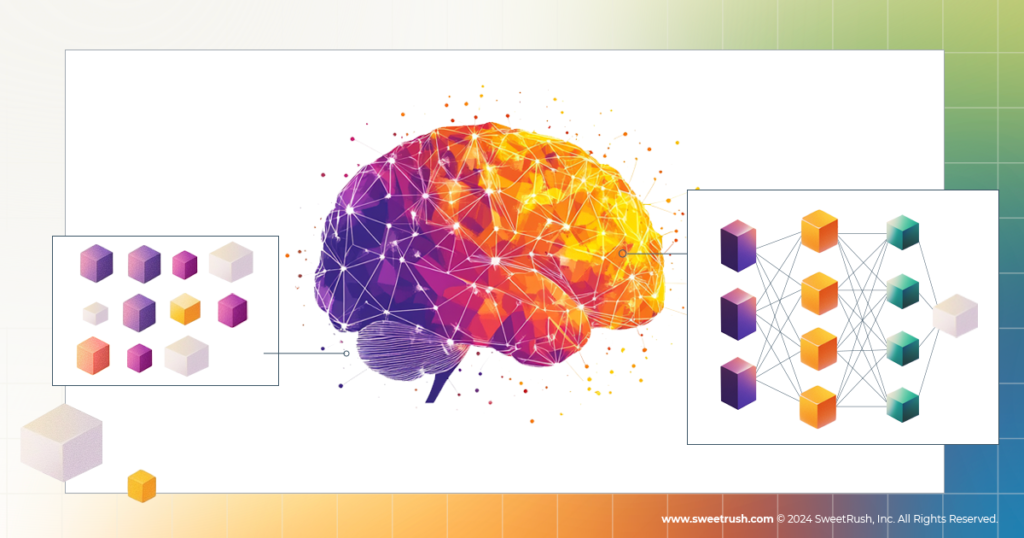AI Glossary for L&D, Part 1: Foundational Concepts

As L&D professionals, we’re no strangers to jargon. Remember when “LIFOW” was just a bunch of letters? Now, “learning in the flow of work” is a cornerstone of our learning experience design (LXD) strategies. But AI has thrown us a curveball. Suddenly, we need to be fluent in a whole new language, complete with its own set of jargon and acronyms.
So, if you’re unsure what “NLP” and “LLMs” are—and how they differ—or are curious about “Deep Learning” and “Backpropagation,” help is at hand! Our AI Glossary for L&D is your go-to guide for simple, straightforward explanations of the concepts, tools, technologies, and methodologies that fall under the umbrella of “AI.”
To make things even easier, we’ve broken the glossary into four parts. In this first part, we introduce the foundational concepts of AI. Over the coming weeks, we’ll continue adding items to the glossary as we expand on the concepts and dive deeper into the “AI-verse.”
Get notified when Parts 2, 3, and 4 of the AI Glossary for L&D go live—follow us on LinkedIn for updates on our latest publications!
The Building Blocks of AI
Let’s begin by laying a solid foundation with the core concepts that underpin the field of AI. In this foundational section, we’ll look at the building blocks of AI, specifically:
AI
Machine Learning
Neural Networks
For each glossary term, you can find a high-level description as well as examples of its common uses and how and where it can be leveraged by L&D teams.
What is AI?
AI is the umbrella term for a wide range of technologies and approaches that are designed to mimic human reasoning and problem-solving abilities.
How and where is AI used?
AI is all around us, powering applications like social media, facial recognition, recommendation systems, and chatbots.
How can L&D leverage and apply AI?
Here are two ways L&D can leverage AI:
To enhance the learner experience via AI-powered learning solutions that provide opportunities for personalized and adaptive learning.
To enhance learning design practices and processes. Learning experience designers can leverage AI throughout their learning solution design workflow. From needs analysis to design, development to implementation and evaluation, there are dozens of tools and technologies to support this work.
Where applicable, we’ll share specific examples of these applications.

What is machine learning?
Machine learning is a subset of AI where systems learn from data and improve their performance on a task without being explicitly programmed. Systems are fed vast amounts of data and use it to recognize patterns, make predictions, and take actions using the data, all without human intervention. There are three main categories of machine learning: supervised learning, unsupervised learning, and reinforcement learning. We’ll explain these advanced concepts in a later addition to the AI Glossary for L&D.
How and where is machine learning used?
Machine learning is the engine behind dozens of everyday applications such as fraud detection, image recognition, and recommendation systems. If you’ve ever used streaming platforms like Netflix or Spotify, you’ve experienced machine learning in action. These platforms analyze your viewing and listening habits to identify patterns and make recommendations tailored to your preferences.
How can L&D leverage and apply machine learning?
Machine learning can be used to analyze learners’ behavior and create personalized learning pathways. Machine learning might also be used to analyze and predict learner performance, recommend relevant content, and even automate the analysis of learner data.

What are Neural Networks?
Neural networks are computational models inspired by the human brain. Neural networks used in machine learning recognize patterns in data. Think of them as interconnected networks of artificial neurons that process information and learn from it, much like our own brains do.
How and where are Neural Networks used?
Neural networks are the backbone of technologies like image recognition, natural language processing, and speech recognition.
How can L&D leverage and apply neural networks?
Neural networks can be configured to power personalized learning experiences, generate adaptive assessments, and provide intelligent feedback.
Ready to dive deeper? Stay tuned for Part 2
Now that you have some of the basic concepts of AI down, stay tuned for Part 2 of the AI Glossary for L&D, where we’ll explore the key technologies that put AI into action!
Follow us on LinkedIn to be updated on its release!
The post AI Glossary for L&D, Part 1: Foundational Concepts appeared first on SweetRush.







